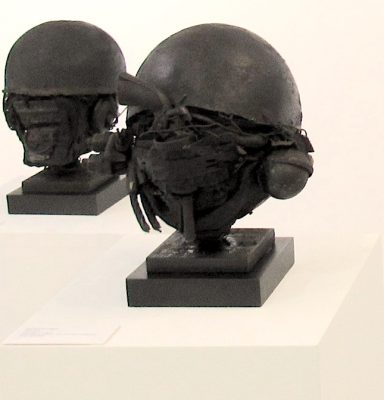Artists Focus on the Horrors of War at Peekskill Exhibit
News Based on facts, either observed and verified directly by the reporter, or reported and verified from knowledgeable sources.

Propaganda and misinformation about war has been around since visual and literary expression became part of the public discourse.
It’s still alive and thriving today, especially now in the age of social media.
Depicting the horrors of battle wasn’t always for public consumption as war was often portrayed as a gallant and heroic pursuit, said art historian Marcy B. Freedman, whose talk last week, “War: An Art History Lecture,” was part of an expansive exhibit at Hudson Valley MOCA in Peekskill entitled “WAR.” The exhibit features about 50 artists whose paintings and sculptures depict the fear and terror of more recent conflicts.
Freedman’s historical account started with the Roman Empire, with sprawling maps of most of Europe and the Middle East, which comprised the Empire. A famous column depicting the wars between the Romans and the Dacians was the Trajan’s Column, which was 125 feet tall with scenes of marching armies, building bridges and a few scenes of actual battle.
For centuries, art glorified war praising leaders as heroic, casting large statues of kings on galloping horses exuding power and authority, such as “The Consequences of War” by Peter Paul Rubens (1577-1640), showing mythical figures in a bloodless frenzy.
Or the famous “Napoleon Crossing the Alps” by Jacques Louis David (1748-1825) with the French King on his fiery steed.
So where were the gory and grisly visuals of what was really happening on the battlefields?
Art was commissioned by patrons who dictated the content to maintain honor and reputation by refraining from showing what was really happening, accounting for the omitted gruesomeness, Freedman explained.
Bloodless wars were the propaganda of the times, at least until Spanish painter Francisco Goya (1747-1828) created the famous “The Third of May 1808” showing Napoleon’s firing squad killing the men of the Spanish resistance during the French occupation. Goya broke centuries of illusionary war scenes and ushered in an unprecedented and abundant production of prints depicting the horrors of war.
Fast forward to both world wars with soldiers who could draw what was going on around them, journalists snapping photographs that fully exposed humanity to what was happening to those in battle. The evils of war were printed on posters, pamphlets and postcards by those in growing resistance movements worldwide.
But the times also produced myriad representations of war honoring soldiers. Praising heroism returned, especially with the U.S. Marine war memorial based on the iconic photograph taken by Associated Press photographer Joe Rosenthal depicting six Marines who raised the second American flag at Iwo Jima on Feb. 23, 1945. Then there is the emotive created by sculptor Maya Lin in 1982 with her Vietnam Veterans Memorial, which included more than 58,000 names of lost soldiers etched into the 200-foot shiny black granite.
Wars, including in Vietnam and Korea, the Gulf War and today’s battles in Gaza and Ukraine have yielded a plethora of antiwar art and sculpture created by artists, many of which were part of “WAR.”
Freedman said most artists today have the freedom today to express antiwar sentiment.
Included in the show is a series, “War Relic #1-3” by Ronald Gonzalez, which includes an eerily darkened soldier’s helmet filled with various items welded together. Where one’s head would be is instead a pistol, rusted artifacts from the trenches including what might be a used grenade.
There is also Katherine Jackson’s “8 Shots,” a large piece of bullet-resistant glass fractured by a 20-gauge slug amplifying the carnage done by a single shot to a fragile human body.
“War” at Hudson Valley MOCA can be seen through Apr. 10. Gallery hours are Thursday and Saturday from 11 a.m. to 5 p.m.
HVMOCA is located at 1701 Main St. in Peekskill. For more information, call 914-788-0100 or visit www.hudsonvalleymoca.org.

Abby is a seasoned journalist who has been covering news and feature stories in the region for decades. Since The Examiner’s launch in 2007, she has reported extensively on a broad range of community issues. Read more from Abby’s editor-author bio here. Read Abbys’s archived work here: https://www.theexaminernews.com/author/ab-lub2019/
